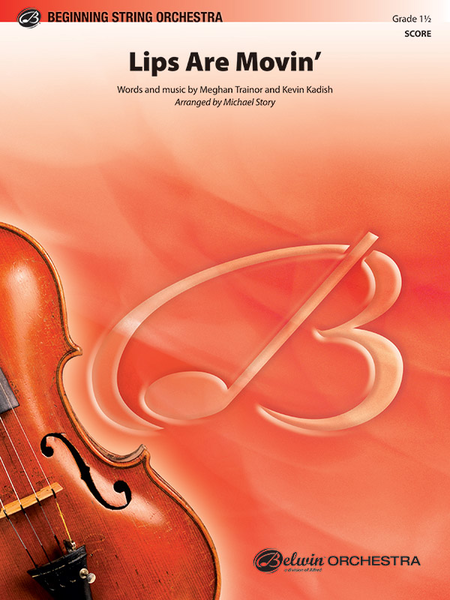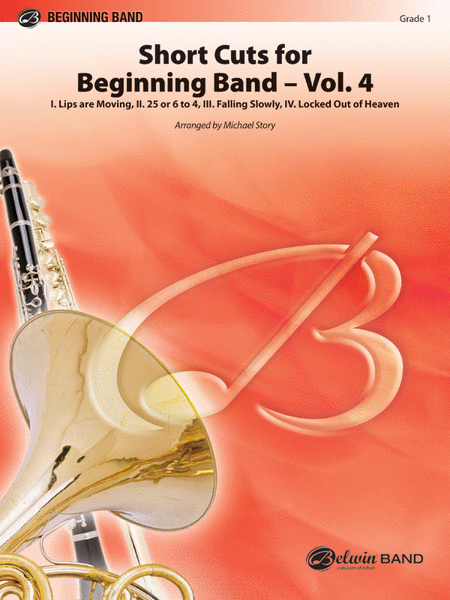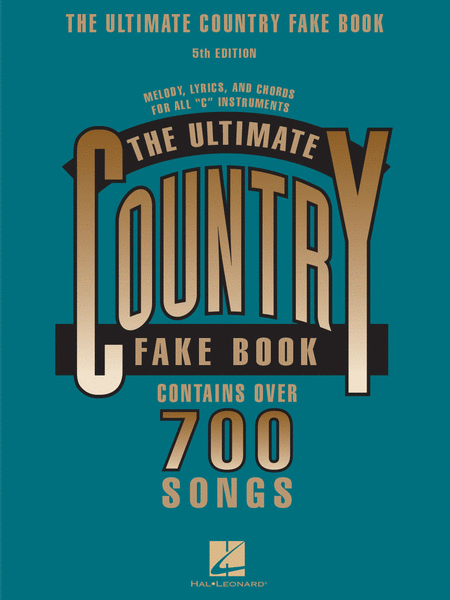|
| Lips Are Movin'
Orchestre à Cordes [Conducteur et Parties séparées] - Débutant
Alfred Publishing
Composed by Meghan Trainor; Kevin Kadish. Arranged by Michael Story. Performance...(+)
Composed by Meghan
Trainor; Kevin Kadish.
Arranged by Michael
Story. Performance Music
Ensemble; Single Titles;
String Orchestra. Pop
Beginning String
Orchestra. Pop. Part(s);
Score. 78 pages. Duration
1:50. Alfred Music
#00-44790. Published by
Alfred Music (AP.44790).
$55.00 - Voir plus => AcheterDélais: 1 to 2 weeks | | | |
| Lips Are Moving
Fanfare [Conducteur] - Facile
Alfred Publishing
Marching Band - Grade 3 SKU: AP.43909S As Recorded by Meghan Trainor(+)
Marching Band - Grade 3
SKU: AP.43909S
As Recorded by Meghan
Trainor. Composed by
Kevin Kadish and Meghan
Trainor. Arranged by
Victor Lopez. Marching
Band; Performance Music
Ensemble; Single Titles.
Mega Sounds for Marching
Band. Pop. Score. 8
pages. Duration 1:55.
Alfred Music #00-43909S.
Published by Alfred Music
(AP.43909S). UPC:
038081502724.
English. Singer/son
gwriter Meghan Trainor is
one of today's hottest
stars. Here is her catchy
hit in a solidly scored
Victor López
arrangement. (1:55). $9.00 - Voir plus => AcheterDélais: 1 to 2 weeks | | | |
| Lips Are Moving
Fanfare - Facile
Alfred Publishing
Marching Band - Grade 3 SKU: AP.43909 As Recorded by Meghan Trainor(+)
Marching Band - Grade 3
SKU: AP.43909
As Recorded by Meghan
Trainor. Composed by
Kevin Kadish and Meghan
Trainor. Arranged by
Victor Lopez. Marching
Band; Performance Music
Ensemble; Single Titles.
Mega Sounds for Marching
Band. Pop. Score and
Part(s). 110 pages.
Duration 1:55. Alfred
Music #00-43909.
Published by Alfred Music
(AP.43909). UPC:
038081502717.
English. Singer/son
gwriter Meghan Trainor is
one of today's hottest
stars. Here is her catchy
hit in a solidly scored
Victor López
arrangement. (1:55). $58.00 - Voir plus => AcheterDélais: 1 to 2 weeks | | | |
| Lips Are Movin'
Orchestre [Conducteur] - Débutant
Alfred Publishing
Orchestra - Grade 1.5 SKU: AP.44790S Composed by Kevin Kadish and Meghan ...(+)
Orchestra - Grade 1.5
SKU: AP.44790S
Composed by Kevin Kadish
and Meghan Trainor.
Arranged by Michael
Story. Performance Music
Ensemble; Single Titles;
String Orchestra. Pop
Beginning String
Orchestra. Pop. Score. 8
pages. Duration 1:50.
Alfred Music #00-44790S.
Published by Alfred Music
(AP.44790S). UPC:
038081515403.
English. Singer/son
gwriter Meghan Trainor is
one of today's hottest
stars. Here is her catchy
hit, Lips Are Movin', in
a very playable
arrangement for your
young string orchestra by
Michael Story. This one
is pure fun! It is a
great piece to reinforce
the use of high and low
second fingers for your
violinists and violists.
(1:50). $9.00 - Voir plus => AcheterDélais: 1 to 2 weeks | | | |
| Short Cuts for Beginning Band -- #4
Orchestre d'harmonie [Conducteur et Parties séparées] - Débutant
Alfred Publishing
(I. Lips Are Moving, II. 25 or 6 to 4, III. Falling Slowly, IV. Locked Out of He...(+)
(I. Lips Are Moving, II.
25 or 6 to 4, III.
Falling Slowly, IV.
Locked Out of Heaven).
Arranged by Michael
Story. Concert Band.
Concert Band; Part(s);
Score. Pop Beginning
Band. Form: Suite. Pop.
Grade 1. 284 pages.
Published by Alfred Music
$61.00 - Voir plus => AcheterDélais: 1 to 2 weeks | | | |
| Piano Gefällt Mir! - Book 5
Piano seul
Bosworth & Co.
The companion MP3 CD to book 5 of the bestselling series Piano Gefällt Mir! b...(+)
The companion MP3 CD to
book 5 of the bestselling
series Piano Gefällt
Mir! by Hans-Günter
Heumann features
demonstration tracks with
recorded Piano, Bass and
Drums, as well as backing
with the Piano part taken
out, allowing you to play
along. **Please note: The
CD included with this
title can only be played
through an MP3 compatible
program.**
$14.95 - Voir plus => AcheterDélais: 2 to 3 weeks | | | |
| Blues and the Soul of Man
Guitare notes et tablatures [Partition + Accès audio]
Mel Bay
Guitar (fingerpicking) SKU: MB.30844M An Autobiography of Nehemiah Ski...(+)
Guitar (fingerpicking)
SKU: MB.30844M
An Autobiography of
Nehemiah Skip James.
Composed by Nehemiah Skip
James. Theory and
Reference, Squareback
saddle stitch. Style.
Book and online audio.
132 pages. Mel Bay
Publications, Inc
#30844M. Published by Mel
Bay Publications, Inc
(MB.30844M). ISBN
9781513464268. 8.75 x
11.75
inches. Skip James was one
of the most influential
early Bluesmen, but his
importance as a stylist
remained undiscovered
until he was brought out
of a long retirement by
the Folk/Blues revival of
the early 1960â??s. Born
in 1902 and raised in
Bentonia, Nehemiah Curtis
James was brought up in a
religious family: his
father was a bootlegger
who reformed and became a
Baptist preacher. Skip
learned piano in school
but picked up guitar from
his friend Henry Stuckey.
In 1931 Skip was picked
up by a scout for
Paramount Records and he
cut 26 tracks, of which
18 were released, in a
two day session at their
Grafton, Wisconsin
studios. These recordings
presented a unique and
haunting genius that
influenced legendary
bluesmen as Robert
Johnson, Kansas Joe McCoy
and Johnny Temple. But
the recordings sold
poorly, having been
released during the Great
Depression, and he
drifted into
obscurity. <
span style=font-family:
Arial;> We have included
as online downloads
Skipâ??s 1931
recordings. The crackling
sound of these rare
recordings cannot obscure
the brilliance of this
seminal Blues
master. After over 30
yearâ??s retirement from
music, Skip was
rediscovered by Blues
enthusiasts Bill Barth,
John Fahey and Henry
Vestine. They persuaded
Skip to appear at the
Newport Folk Festival in
1964, where his
renditions of his old
songs were still powerful
and moving. His
performances as well as
his old and new
recordings influenced a
generation of new
musicians: Eric Clapton,
Alan Wilson of Canned
Heat, Cream, Deep Purple,
Chris Thomas King, Alvin
Youngblood Hart, Derek
Trucks, Beck, Big Sugar,
John Martyn, Lucinda
Williams and Rory Block
to name a
few. Books on
legendary Blues musicians
written by white
musicologists tend to
offer a subjective
perspective on how the
artists felt, thought or
reacted. A tainted
picture is captured that
has more to do with the
writerâ??s social and
musical experiences. This
autobiography is
different. The words,
thoughts and feelings
come directly from the
artistâ??s lips. This is
the story of Nehemiah
â??Skipâ? James told
by Nehemiah â??Skipâ?
James. $24.95 - Voir plus => AcheterDélais: 1 to 2 weeks | | | |
| Short Cuts for Beginning Band -- Vol. 4
Orchestre d'harmonie [Conducteur] - Débutant
Alfred Publishing
Concert Band - Grade 1 SKU: AP.44897S I. Lips Are Moving, II. 25 or 6 ...(+)
Concert Band - Grade 1
SKU: AP.44897S
I. Lips Are Moving,
II. 25 or 6 to 4, III.
Falling Slowly, IV.
Locked Out of Heaven.
Composed by Various.
Arranged by Michael
Story. Collections;
Concert Band; Performance
Music Ensemble; Single
Titles. Pop Beginning
Band. Form: Suite. Pop.
Score. 36 pages. Duration
4:45. Alfred Music
#00-44897S. Published by
Alfred Music (AP.44897S).
ISBN 9781470661410.
UPC: 038081515687.
English.
Various. This
four-pack for beginners
is designed to serve as a
complete or partial
repertoire for their
first end-of-year concert
while reinforcing eighth
note counting, percussion
two-hand coordination,
and legato and expressive
performance. Be sure to
check out volumes 1, 2,
and 3 to expand your
performance
possibilities.
(4:45). $10.00 - Voir plus => AcheterDélais: 1 to 2 weeks | | | |
| The Ultimate Country Fake Book - 4th Edition
Fake Book [Fake Book]
Hal Leonard
Fake Book (Includes melody line and chords). Size 9x12 inches. 568 pages. Publis...(+)
Fake Book (Includes
melody line and chords).
Size 9x12 inches. 568
pages. Published by Hal
Leonard.
(8)$55.00 - Voir plus => AcheterDélais: 24 hours - In Stock | | | |
| 36 Celebrated Studies for the Cornet
Carl Fischer
Chamber Music Cornet SKU: CF.O88X Composed by Narcisse Bousquet. Edited b...(+)
Chamber Music Cornet
SKU: CF.O88X
Composed by Narcisse
Bousquet. Edited by Joey
Tartell Edwin Franko
Goldman. SWS. Softcover.
With Standard notation.
44 pages. Carl Fischer
Music #O88X. Published by
Carl Fischer Music
(CF.O88X). ISBN
9781491153406. UPC:
680160910908. 9 X 12
inches. These
studies are a staple of
the advanced trumpet
method repertoire. Each
etude is an exploration
of a wide variety of
registers, articulations
and tonalities. While
going through these 36
etudes the trumpeter will
develop an even sound in
all registers while
tackling the musical and
melodic challenges that
lie
within.
IntroductionTi
ps on Musical
PracticeStarting a new
study can be
overwhelming. Using Etude
No. 1, here’s an
example of how to
approach working on these
etudes with both
musicality and technique
in mind.Bousquet’s
first study can be broken
down into three large
musical sections:Section
1: from the beginning to
the downbeat of m.
26.Section 2: from the
upbeat of 2 in m. 26 to
the downbeat of m.
51.Section 3: from the
downbeat of m. 51 to the
end.Each one of those
sections can be broken
down into two smaller
sections:Section 1a: from
the beginning to the
downbeat of m. 16.Section
1b: from the downbeat of
m. 16 to the downbeat of
m. 26.Section 2a: from
the upbeat of 2 in m. 26
to the end of m.
35.Section 2b: from m. 36
to the downbeat of m.
51.Section 3a: from the
downbeat of m. 51 to the
downbeat of m. 59.Section
3b: from the downbeat of
m. 59 to the end.To get
started playing, choose a
slow tempo that allows
you to play Section 1 all
the way through without
stopping. If that is
problematic, just play
through 1a.Remember to
focus on the music.
Section 1a is light,
moving in four-measure
phrases to the ninth
measure, where it
cadences in G. From
there, retain the
lightness through the
arpeggiation that
concludes with the trill
that brings an arrival
point at Section 1b. Here
the style changes
completely, alternating
two measures of fluid,
connected sixteenth notes
with two measures of
scalar staccato
sixteenths before finally
cadencing on the downbeat
of m. 26.Section 2 begins
with a melodic line of
eighth notes, punctuated
by sixteenths in the
third full measure before
returning to the original
line for only a measure
before driving forward
with a flourish to finish
Section 2a. Section 2b
starts back in C with
four-measure phrases in
which the line moves up
for two measures, then
down for two measures,
ending in G. The last
seven measures of Section
2 stay light as they work
their way back to
C.Section 3 is very
exciting, starting with a
fiery cornet solo-like
passage in 3a. 3b brings
the piece to a dramatic
conclusion outlining C
major for the first four
measures before
arpeggiating C major and
G dominant for two
measures, finally
finishing with the
C-major scale.The next
step is to isolate any of
the parts that proved
troublesome. Examples
could include missed
notes or figuring out
where to breathe. Once
you have practiced the
troublesome sections in
isolation, play the
section all the way
through without stopping
again. Even if there are
still problems, you are
now practicing in a way
that is preparing you to
perform musically.The
next day, play through
Section 1 again, at a
tempo that allows you to
do this without stopping.
Now go on to Section 2,
and follow the same three
steps:Play all the way
through, at a tempo that
allows you to do so
without stopping,Isolate
and practice the
troublesome passages,
thenPlay all the way
through, at a tempo that
allows you to do so
without stopping.Now play
from the beginning to the
end of Section 2.The next
day, play Section 1. Now
play Section 2. Then play
Section 3 and apply the
same three steps outlined
above.Now play the whole
study. At this point you
have spent time on each
section, making musical
decisions and correcting
mistakes. Increase the
tempo as you gain
confidence and control of
the material. As you work
towards performing the
entire study as a piece
of music, record yourself
playing the entire study
as a performance each
day. Review the
recordings to reveal what
still needs work. Be
honest with yourself!
When you are happy with
the recording of your
performance, it’s
time to move on to the
next study.About the
Goldman PrefaceThese
studies will be an
excellent practice,
especially for the lower
register of the Cornet,
which is somewhat
neglected in other
instruction books. It is
recommended that the
pupil should practice one
of this series of Studies
now and then to repose
his lips, and acquire
facility in difficult
fingering.— Edwin
Franko GoldmanIn his
original preface, Edwin
Franko Goldman is
absolutely correct that
these studies are
excellent practice and
will help with the
dexterity demanded of
today’s player.
Although the low register
is certainly explored
throughout the book, it
does not appear to be the
focus of these studies.
There are many books
available now that
concentrate on the low
register. The suggested
fingerings have been
removed. Using alternate
fingerings was more
common to cornet players
to aid in the fluidity of
a passage. This practice
is not nearly as common
today, especially with
trumpet players, as the
difference in timbre
caused by the alternate
fingerings is disruptive
to the musical line.
Published for cornet, as
it was the solo
instrument of choice in
the 1920s, these etudes
are just as useful to
today’s trumpet
player. When playing
these studies on trumpet,
the performer should
strive for a fluid line
while maintaining a full
and clear sound. Because
of the musicianship and
technique demanded, this
book remains as useful
today as it has ever
been.— Joey
TartellAbout Narcisse
Bousquet and the 36
EtudesNarcisse Bousquet
(c. 1800–1869) was
French by birth, active
as a composer, editor and
arranger in both France
and England in the early
nineteenth century.
Bousquet was respected as
an accomplished performer
of the French flageolet,
a high-pitched woodwind
instrument much like a
recorder, although later
outfitted with the Boehm
key system like the
modern flute. Although
obsolete in modern times,
the instrument once
enjoyed great popularity
with a variety of
composers and performers,
both amateur and
professional. Purcell and
Handel composed for the
instrument, and Berlioz
was purportedly an
accomplished amateur
performer of the
flageolet. The Scottish
author Robert Louis
Stevenson, likewise, was
a proficient performer of
the instrument and
composed a number of
pieces for it.Little is
known today of
Bousquet’s life.
He composed a large
variety of music,
including works
specifically for the
flageolet, which were
widely appreciated in
their day. The 36 Etudes
for flageolet are
undoubtedly the most well
known of his works.
Published in 1851, the
Etudes explore a variety
of techniques, such as
scales, arpeggios,
ornamentation, breath
control and expressive
playing, and their
technically demanding
writing confirms
Bousquet’s prowess
as a flageolet performer.
However, the date of the
arrangement of the etudes
for cornet and their
arranger remain
speculative. Edwin Franko
Goldman is credited as
the arranger of the 1890
publication by Carl
Fischer, although Goldman
would have been only
twelve years old at the
time; his work on these
pieces surely came at a
later time. Bousquet
himself may have arranged
these pieces for cornet
at the request of an
accomplished cornet
player at some point
after their
publication. $16.99 - Voir plus => AcheterDélais: 1 to 2 weeks | | |
|









